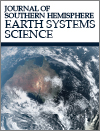ES25015Disentangling the uncertainties in regional projections for Australia
 , Michael Grose
, Michael Grose  , Francois Delage, Gen Tolhurst, Christine Chung
, Francois Delage, Gen Tolhurst, Christine Chung  , Alicia Takbash, Ghyslaine Boschat, Malcolm King, Acacia Pepler
, Alicia Takbash, Ghyslaine Boschat, Malcolm King, Acacia Pepler  , Marcus Thatcher, Benjamin Ng
, Marcus Thatcher, Benjamin Ng  , Son Truong
, Son Truong  , Chun-Hsu Su
, Chun-Hsu Su  , Emma Howard
, Emma Howard  , Christian Stassen
, Christian Stassen  , Mitchell Black
, Mitchell Black  , David Jones, Richard Matear, Sarah Chapman
, David Jones, Richard Matear, Sarah Chapman  , Jozef Syktus, Ralph Trancoso, Giovanni Di Virgilio, Rishav Goyal, Jatin Kala, Vanessa Round and Jason P. Evans
, Jozef Syktus, Ralph Trancoso, Giovanni Di Virgilio, Rishav Goyal, Jatin Kala, Vanessa Round and Jason P. Evans 
Long-term projections of Australia’s future climate span a wide range of plausible outcomes. The differences in these projections arise owing to differences in greenhouse gas emissions pathways, models and natural variability in the climate. Here, we show that when considering sub-continental-scale projections of temperature, it is most important to carefully consider atmospheric composition scenario differences, whereas for rainfall, it is most important to adequately sample a wide range of climate models.
This article belongs to the collection: Model evaluation for CMIP and IPCC AR7.
ES25015 Abstract | ES25015 Full Text | ES25015PDF (9 MB) | ES25015Supplementary Material (3.6 MB) Open Access Article



